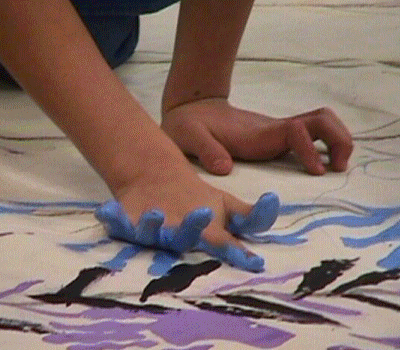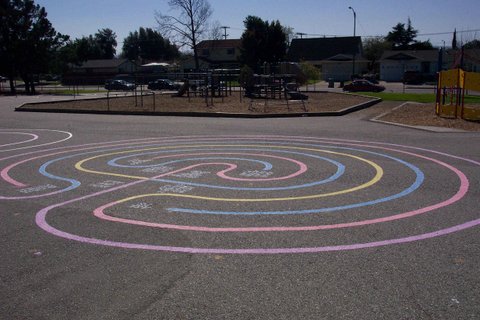Labyrinths in Places
Labyrinths are found in many places. Some are permanent and some are brought in temporarily for events. The challenge for labyrinth enthusiasts is often how to get permission to introduce a labyrinth into a specific environment. This section of the website examines some of the places where labyrinths may be found, the benefits of having them there, how they are used, and how people were able to install them there in the first place!
Labyrinths in Schools and Other Educational Centers

We know that labyrinths have blossomed in schools, colleges, and universities across the United States in recent years. On the record as of March, 2016, there are 383 labyrinths located in schools or other educational centers in 39 countries listed in the World Wide Locator. No doubt there are many around the world that aren’t listed. The ones that are listed vary as much as do labyrinths in general. The labyrinths in educational settings vary in size, type, material, and location, whether indoors or out. The commonality is that the labyrinths are used in educational settings, and at least in part, for educational purposes. Labyrinths and labyrinth activities are easily adapted for populations of any age, and schools, colleges, and universities utilize activities for personal growth, self-discovery, community building, conflict resolution, and recreation. Labyrinths are an attractive and useful addition to campuses around the world.
Why are labyrinths thriving in schools? Children respond immediately to the pattern of a labyrinth. Of course, they first want to race to the middle and out again as fast as they can, but with training they can also use it for such things as dealing with grief, problem solving, conflict resolution, building community and celebrating joyful events. Many teachers have found ways to use the labyrinth to enrich learning experiences.
There are many TLS members working with children and labyrinths. Some of those have summarized their work below. They would welcome questions and comments about their work.
Elementary School - Art Project: Annemarie Rawlinson
I am an artist and coordinated a Finger Labyrinth project for an art enrichment program in elementary schools in the South Bay of Los Angeles. The labyrinths were made out of air-drying clay and painted. The lower grades made spiraling designs - snails, hearts, waves, etc. The upper grades learned how to create a Cretan Labyrinth using the seed pattern. This project informed 4,000 children about the labyrinth. For more info contact Annemarie Rawlinson.
Elementary School - Art Project: Labyrinths for Creativity and Peace with artist Sandra Wasko-Flood
Through the national non-profit organization, Living Labyrinths for Peace, Inc., Sandra Wasko-Flood has conducted workshops in over 50 schools in the Washington, DC area sponsored by the Washington Performing Arts Society (WPAS), and more recently, in the Baltimore, MD and Taos, NM schools.
Students walk labyrinths to find a path to themselves, to stimulate creativity, express wishes, make decisions, and resolve conflicts. Through posters and diagrams, they learn labyrinth vocabulary, and create Labyrinth Books with designs in many media. Together with their classmates, they can paint a 12-foot square canvas labyrinth and/or one outdoors dedicated to the children of their school. Here they celebrate important events in their lives and those of their communities. They walk labyrinths making peace wishes for themselves, family, friends, community, and the world.
For further information, contact Sandra Wasko-Flood by email or phone:
410-243-1189 (home) or 703-217-6706 (cell).
Elementary School: Connie Fenty
 While a teacher at Lower Southampton Elementary School in Feasterville, PA. I facilitated an annual Peace Week. Featured along with many other activities, students were trained in using the "Peace Maze," a rainbow colored seven circuit labyrinth. The labyrinth was painted on the playground and displayed the language of conflict resolution at each turn. Since then, I have duplicated the "Peace Maze in the other elementary schools in the district as well as schools in other states.
While a teacher at Lower Southampton Elementary School in Feasterville, PA. I facilitated an annual Peace Week. Featured along with many other activities, students were trained in using the "Peace Maze," a rainbow colored seven circuit labyrinth. The labyrinth was painted on the playground and displayed the language of conflict resolution at each turn. Since then, I have duplicated the "Peace Maze in the other elementary schools in the district as well as schools in other states.
For more info contact Connie Fenty and visit the Your Nature Connection website.
Special Needs - Cultural Diversity Education: Virginia LoneSky
I work in culturally and educationally challenged environments, and with special needs children using single and double-labyrinth exercises to help children touch their creative sides, and stimulate their imaginations. I will partner with any existing group that works with children in an inner city or Reservation environment to integrate their culture into the use of labyrinths. I provide guidance and mentoring also, for the adults and teachers, on how to use the labyrinth to encourage and stimulate the children’s needs for exercise of the body and mind, and for them to develop innovative programs, advocating the building of walkable labyrinths on playgrounds for recess, and distributing labyrinth patterns for their free time, for tracing with their fingers.
For more information, contact Virginia LoneSky or visit the Peaceful Endeavours website.
Ages 3-18, Education: Gael Hancock
Kindergarten through Adult: I have had the extraordinary opportunity to present the labyrinth in a variety of schools in Las Vegas -- a Muslim school, a high-risk adult school, private and parochial schools and inner-city schools. I would be happy to discuss my presentation, the interesting teacher/student reactions and the resulting long-term labyrinth activities. For this and information on how to take your labyrinth program into schools, contact Gael Hancock.
Montessori Education: Beth Langley
Montessori schools are among the many schools adding labyrinths to their outdoor and indoor environments. Walking or using a labyrinth is very “Montessori”—it’s a self-correcting lesson in concentration! Montessorians consciously incorporate peace education in the curriculum and encourage children to grow internally. The labyrinth can be a valuable tool in all those things—whether helping a child regain self-control, friends working through a problem, a group celebrating community or as a place for active self-discovery for an individual. Many classrooms have a finger labyrinth on a “Peace Table” that is used for calming, reflection, or just for the intrinsic fun of “walking the labyrinth.” Incorporating labyrinths in ceremonies or rituals and using them for special occasions is appropriate for any school, Montessori or not!
M.E. (Beth) Langley has been presenting at Montessori conferences on the subject of labyrinths and designing and installing labyrinths (many at Montessori schools) since 2006. Her website at www.LastingLabyrinths.com includes photos, resources and links to follow for labyrinth exploration. She has written a Montessori-style presentation on labyrinths and included it on the Files for Sharing page. Beth loves to consult with individuals and groups to create unique labyrinths and labyrinth experiences for groups of any size. You can contact her by e-mailing Beth Langley.
